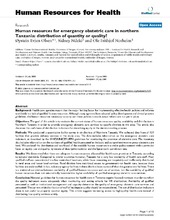| dc.contributor.author | Olsen, Øystein Evjen | en_US |
| dc.contributor.author | Ndeki, Sidney | en_US |
| dc.contributor.author | Norheim, Ole Frithjof | en_US |
| dc.date.accessioned | 2010-07-07T11:24:04Z | |
| dc.date.available | 2010-07-07T11:24:04Z | |
| dc.date.issued | 2005-07-29 | eng |
| dc.Published | Human Resources for Health 3(5) | en |
| dc.identifier.issn | 1478-4491 | |
| dc.identifier.uri | https://hdl.handle.net/1956/3991 | |
| dc.description.abstract | Background: Health care agencies report that the major limiting factor for implementing effective health policies and reforms worldwide is a lack of qualified human resources. Although many agencies have adopted policy development and clinical practice guidelines, the human resources necessary to carry out these policies towards actual reform are not yet in place. Objectives: The goal of this article is to evaluate the current status of human resources quality, availability and distribution in Northern Tanzania in order to provide emergency obstetric care services to specific districts in this area. The article also discusses the usefulness of distribution indicators for describing equity in the decision-making process. Methods: We conducted a quantitative facility survey in six districts of Northern Tanzania. We collected data from all 129 facilities that provide delivery services in the study area. The data includes information on the emergency obstetric care indicators, as described by the WHO/UNICEF/UFPA guidelines for monitoring the provision of obstetric care. The inventory also includes information on the numbers of qualified health personnel at the basic and comprehensive emergency obstetric care level. We analysed the distribution and workload of the available human resources in a wider policy context with a particular focus on equity, use and quality, by means of descriptive statistics and the Spearman's correlation test. Results: We determined that there are adequate human resources allocated for health care provision in Tanzania, according to national standards. Compared to similar countries however, Tanzania has a very low availability of health care staff. Most qualified staff are concentrated in a few centralized locations, while those remaining are inequitably and inefficiently distributed in rural areas and lower-level services. Rural districts have restricted access to government-run health care, because these facilities are understaffed. In fact, voluntary agency facilities in these districts have more staff than the government facilities. There is a statistical correlation between availability of qualified human resources and use of services, but the availability of qualified human resources does not automatically translate into higher availability of qualified emergency obstetric care services. Conclusion: National guidelines for human resources for health care in Tanzania require focused revisions in order to reflect the quality indicators more adequately when monitoring and setting criteria for HR distribution. Availability of qualified personnel as well as institutional management and capacity determine the quality of emergency obstetric care services and personnel. The current wide distribution of staff of inadequate quality should be reconsidered. The use of distribution indicators alone is not useful to properly monitor equity. This article suggests increasing access to high-quality health care instead of distributing low-quality services widely. | en_US |
| dc.language.iso | eng | eng |
| dc.publisher | BioMed Central | eng |
| dc.rights | Attribution CC BY | eng |
| dc.rights.uri | http://creativecommons.org/licenses/by/2.0/ | eng |
| dc.title | Human resources for emergency obstetric care in northern Tanzania: distribution of quantity or quality? | en_US |
| dc.type | Peer reviewed | |
| dc.type | Journal article | |
| dc.description.version | publishedVersion | en_US |
| dc.rights.holder | Copyright 2005 Olsen et al; licensee BioMed Central | |
| dc.identifier.doi | https://doi.org/10.1186/1478-4491-3-5 | |
| dc.subject.nsi | VDP::Medisinske Fag: 700::Helsefag: 800::Samfunnsmedisin, sosialmedisin: 801 | nob |

